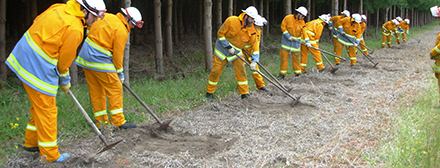The Softwoods Working Group is joining a growing chorus of voices telling the Bushfire Royal Commission that fuel loads in public and private forests last summer were at an “unacceptable” level and had been allowed to build up, “making fire prevention almost impossible.” Source: Tumut and Adelong Times
Those statements were made by SWG Chair Peter Crowe in a written submission made public by the Commission last week.
“In my opinion, current bushfire management is deficient and ‘accepted’ assumptions and practices must now be urgently reviewed,” wrote Mr Crowe.
“The managers of both public and private forests should be reviewing and amending their fire management practices. For example, it appears that the NP&WS has done very little to prevent fuel load build up in Parks and Reserves (which often border or surround commercial forests) and private forests in NSW have no legal requirement to have any minimum fire protection protocols in place.”
The SWG is made up of representatives from the major forest growers (NSW Forestry Corporation, and private growers, including Hume Forests), timber processors (AKD Softwoods, Hyne Timber, Visy Industries), Local Governments (Snowy Valleys Council, Greater Hume Council, Cootamundra-Gundagai Regional Council, and Albury City) and other regional and state bodies.
Mr Crowe outlined the forestry industry’s importance to the local region, describing it as “the most significant economic driver in the region” with a total employment (direct and indirect) of approximately 5000 jobs and a $2 billion annual contribution to the local economy.
“It has been well documented that the softwood plantation-based industry of the South West Slopes region was severely affected by the Dunns Road and Green Valley fires which burnt around 40% of the total plantation resource,” he said.
“If no action is taken, it is anticipated that the adverse social, economic and commercial impacts could be commensurate with this figure. However, some action can be taken which will help mitigate the impacts to some extent.”
He pointed to Snowy 2.0 as a possible source of jobs for those displaced in the forestry industry, “however, recovery efforts should also be focussed on other additional alternatives for the region. The task of potentially needing to replace up to $800 million per year in economic activity cannot be under-estimated.”
The SWG made several recommendations for fire preparedness, including greater training for land management personnel, accurate mapping of fire trails and fire breaks, and greater hazard reduction within native forests and in and around plantations.
“Hazard reduction strategies can include both fire-based techniques (i.e. controlled burning) and mechanical techniques (i.e. physical removal and/or mulching of understorey debris.)” wrote Mr Crowe.
He also recommended the Commission listen to non-institution fire fighters in key locations who “often have long experience within their local areas, and their views could provide a very useful resource to assist the Commissioners in their review.”
The SWG also recommended the “value of a ‘stay and defend’ fire-fighting strategy should be assessed.”
“In the SW Slopes, at least, this non-sanctioned approach saved a lot of properties and arguably some smaller townships.”






